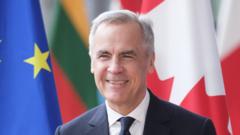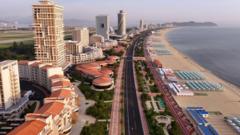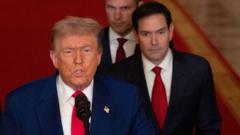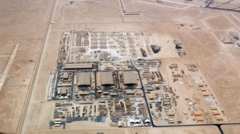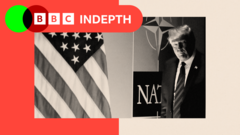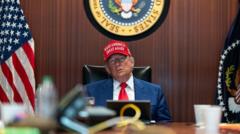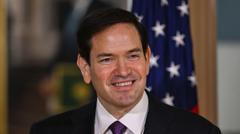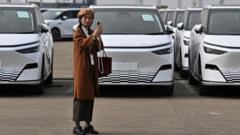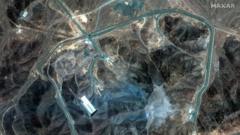President Xi Jinping of China is confronted with significant domestic economic challenges as Trump's tariffs continue to pressure China's already struggling economy. With concerns over housing, job prospects, and consumer confidence, experts believe the real issue for Xi lies within China itself and its ability to stimulate internal demand and navigate an evolving global trade landscape.
Xi's Economic Challenge Amidst Trump's Tariff Policies
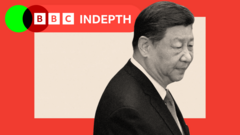
Xi's Economic Challenge Amidst Trump's Tariff Policies
As Donald Trump's tariff strategies permeate global markets, China faces a crucial test of economic resilience and domestic confidence under Xi Jinping.
In the bustling markets and trade fairs of China, the mention of Donald Trump and his aggressive tariff policies elicits amusement rather than dread among traders. The impact of his tariffs—set at a staggering 145%—has been met with a wave of online satire by Chinese nationalists, showcasing a resilient nationalistic spirit amidst external economic pressure. President Xi, echoing a sentiment of self-reliance, has signaled that China will not buckle under perceived unreasonable pressure.
Since Xi assumed power in 2012, he envisioned revitalizing China's economy; however, that vision faces hurdles exacerbated by issues like a housing crisis, a rising elderly population, and a youth unemployment rate exceeding 20%. The confidence that once propelled consumer spending is faltering, not solely attributed to Trump's tariffs but fundamentally tied to a collapsed housing market where investments have become liabilities.
The adverse effects of overbuilding have resulted in scores of unoccupied housing units, with estimates suggesting empty homes for billions, leading to a visible lack of consumer spending. Analysts now predict a 2.5% dip in home prices this year, compounding woes for residents grappling with thoughts of pension security and employment prospects for younger generations.
Despite domestic challenges, Xi is mindful that the rising discontent could manifest in protests, though these are quickly suppressed. The Communist Party’s hold on power hinges on economic stability—a promise Xi made in 2012 during a more optimistic economic phase. With the international economic outlook shifting, Xi faces a rigorous political test, as disillusioned youth may pose a growing risk.
In navigating these testing waters, China has begun to seek solutions within—boosting wages, providing childcare subsidies, and introducing initiatives aimed at stimulating consumption. However, experts voice skepticism about the potential for immediate impacts. Transitioning from export reliance to domestic demand is a slow, complex endeavor.
Geopolitically, while Xi looks to diversify China's trade ties and solidify relationships, especially in Southeast Asia and the Global South, past diplomatic frictions complicate this outreach. A looming question remains whether Xi can leverage the current climate shaped by Trump's tariffs into a strategic advantage for China on the world stage.
Although Xi's government endeavors to adapt to changing markets and strengthen domestic resilience, the core issue hinges upon altering consumer sentiment in a population weary from economic fluctuations. If Xi can turn these pressures into opportunities rather than setbacks, it could define his leadership and China's global role for years to come.
Since Xi assumed power in 2012, he envisioned revitalizing China's economy; however, that vision faces hurdles exacerbated by issues like a housing crisis, a rising elderly population, and a youth unemployment rate exceeding 20%. The confidence that once propelled consumer spending is faltering, not solely attributed to Trump's tariffs but fundamentally tied to a collapsed housing market where investments have become liabilities.
The adverse effects of overbuilding have resulted in scores of unoccupied housing units, with estimates suggesting empty homes for billions, leading to a visible lack of consumer spending. Analysts now predict a 2.5% dip in home prices this year, compounding woes for residents grappling with thoughts of pension security and employment prospects for younger generations.
Despite domestic challenges, Xi is mindful that the rising discontent could manifest in protests, though these are quickly suppressed. The Communist Party’s hold on power hinges on economic stability—a promise Xi made in 2012 during a more optimistic economic phase. With the international economic outlook shifting, Xi faces a rigorous political test, as disillusioned youth may pose a growing risk.
In navigating these testing waters, China has begun to seek solutions within—boosting wages, providing childcare subsidies, and introducing initiatives aimed at stimulating consumption. However, experts voice skepticism about the potential for immediate impacts. Transitioning from export reliance to domestic demand is a slow, complex endeavor.
Geopolitically, while Xi looks to diversify China's trade ties and solidify relationships, especially in Southeast Asia and the Global South, past diplomatic frictions complicate this outreach. A looming question remains whether Xi can leverage the current climate shaped by Trump's tariffs into a strategic advantage for China on the world stage.
Although Xi's government endeavors to adapt to changing markets and strengthen domestic resilience, the core issue hinges upon altering consumer sentiment in a population weary from economic fluctuations. If Xi can turn these pressures into opportunities rather than setbacks, it could define his leadership and China's global role for years to come.

